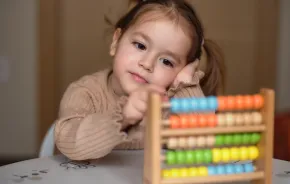 I sometimes wonder if, as a former early education advisory teacher, my expectations of preschool are unrealistic.
I sometimes wonder if, as a former early education advisory teacher, my expectations of preschool are unrealistic.
Since moving here from the UK, I am constantly disappointed at what I find: long waiting lists, high fees, no full-day kindergarten, lack of flexibility, rigid timetabling . . . the list goes on. With this in mind, I am always interested in what other parents think, especially those with experience of other systems. I asked a Swedish friend recently what she thought of the preschool system here. She laughed. "Preschool system? What preschool system?"
Perhaps she has a point.
I am heartened by the prevalence of early childhood education on the political agenda and that Washington State is at the forefront of some of those changes. In comparison to the UK, where many feel the system is taking a backward step, this is indeed encouraging. However the reality, as both a parent and teacher, is that I see little opportunity for myself and my children within the current system.
My two youngest children are 5 and 3. I watch their peers in the UK with interest: 5-year-olds who are in full-time school and 3- year-olds in government-funded pre-school, and I wonder if my children are disadvantaged. Teachers complain a lot in the UK (often with just cause), but I think in many ways we forget how far early education has come in the past 20 years.
Flexibility
According to the UK Department of Education's Early Years Census for 2011, 95% of 3-year-olds and 98% of 4-year-olds in England are enrolled in state-funded preschool. All children receive 15 hours per week (for 38 weeks of the year) of preschool funding from the start of the term following their 3rd birthday. This can be used at an independent preschool, voluntary preschool, state-maintained nursery, children’s centre or with a home-based childminder. To receive the grant, childcare facilities need to be registered with Ofsted, the government organisation responsible for regulating quality, and undertake an inspection every two to four years. Childcare facilities are inspected against the Early Years Foundation Stage (EYFS), which outlines care and education standards.
Parents can use their 15 hours flexibly, spreading it between more than one setting or for up to 10 hours on any one day. My middle daughter had three sessions at a local preschool and one six-hour day with a childminder; my eldest daughter used hers for five sessions at a school-based nursery. The UK government are also currently trialling state-funded sessions for disadvantaged 2-year-olds.
How it works
In the UK, children start school the September after their 4th birthday. All children attend school for full days after a settling period of half days during the first six weeks. They follow a play-based curriculum for the first year of school (Reception Year) before moving to more academic learning the following year. It is slightly different In Wales, where children follow a play-based curriculum for the first three years of school. I was shocked when I moved here with my October-born girls. I was aware that the girls would start school a year later here than in the UK, but I wasn’t prepared for them starting full-time school when they are nearly 7, unless we pay for the afternoon session. By this time, their peers in the UK will have completed nearly three years of full-time school. My 3- year-old, for example, will start school a year later here than her younger, prematurely born cousins in the UK.
The Early Years Foundation Stage (EYFS) is the statutory framework that sets the standards that all Early Years providers must meet to ensure that children learn and develop and are kept healthy and safe. This is a little bit like a curriculum for older children, but it's designed to be really flexible and follow a child's unique needs and interests. It is founded on the principal that children in the EYFS learn by playing and exploring, being active, and through creative and critical thinking, which takes place both indoors and outside.
Though quality is variable, as a result of the EYFS, you have a rough idea of what you are going to see when you visit a preschool in England. Here, there are such vast differences in what is available, that it can be overwhelming. In England, at least when the choice becomes overwhelming you can decide to apply for a place at the nursery class of your local school and know that you will get highly qualified, paid and respected teachers.
Teacher quality and pay
There is a commitment in the UK to training a quality workforce. The government hoped to encourage highly qualified and committed graduates to enter the profession, by establishing the Early Years Professional Status in 2007 (recently replaced by the Early Years Teacher Status). Unless you work in a school nursery or reception class, there is still disparity between the pay of teachers of older children and preschool teachers, but this new qualification is starting to bridge that gap.
The English system is by no means perfect. There are constant discussions amongst my former colleagues about unnecessary changes, too much testing, the early school starting age, fear of moving toward inappropriate academic learning at an ever earlier age, and teachers are fearful of the direction in which early education is moving.
Here, there is much excitement about change, opportunity to push the boundaries and make a difference. Sadly I feel it will all come a little too late for my children, so for now I’m enjoying the extra year I have with them at home and doing it my way.











